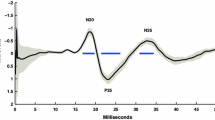Abstract
Objective: In patients sustaining severe brain damage (SBD), prediction of later outcome is often very difficult, in particular under conditions of therapeutic management like relaxation and intravenous phenobarbital. Somatosensory evoked potentials (SEP) correlated best with later prognosis and expected neurological deficit. In detail, the primary bilateral loss of cortical responses (BLCR) is regarded to be a reliable marker for poor prognosis. The goal of the following prospective study was to reassess the prognostic value of early serial median nerve SEP recording in severe brain damage in comparison to other neurophysiologica, clinical, and neuroradiological parameters and, additionally, to test the hypothesis, that the BLCR-pattern is always associated with a poor prognosis and is never reversible. Design: Prospective study. Setting: Anaesthesiological hospital intensive care unit. Patients and participants: 42 comatose patients with severe brain damage (29 males/13 females), mean age 39.6 ± 19.3 years, mean initial Glasgow Coma Score (GCS) 6.6 ± 3.1, investigated by means of median somatosensory evoked potentials (SEP) and brainstem auditory evoked potentials (BAEP) with serial recordings on day 1, 3 to 4, and 8 to 1, and repeated cra- nial computerized tomo- graphy. Measurements and results: We classified the outcome according to the Glasgow Outcome Scale (GOS). Our data showed a high correlation of initial SEP scores (Spearman correlation coefficient = − 0.70) with outcome for both a favorable and an unfavorable prognosis (p = 0.0001). The reliability increased with serial recordings. The SEPs showed superiority to parallel brainstem auditory evoked potentials (Spearman correlation coefficient = − 0.50, p = 0.0007), GCS, and standardized neuroradiological criteria. Primary (BLCR) occurred in 16 patients (38 %) and implied a fatal prognosis in all adult patients (n = 15, specificity = 93.3 %, sensitivity = 59.3 %). In contrast, a young child with predominant brainstem hemorrhagic contusions regained consciousness and developed mild to moderate neurological deficit (GOS 3–4) during long-term follow-up of 4 years. This clinical improvement paralleled bilateral asymmetric recovery of cortical SEP responses. Conclusions: SEP allow an early reliable assessment of both poor and good prognosis in SBD, in particular when applied serially. BLCR does not always imply a fatal diagnosis, as a circumscribed contusional lesion rarely may lead to selective reversible blockage of ascending somatosensory pathways in the brainstem. In contradiction to this lesional etiology, a hypoxia-induced BLCR pattern seems to correlate strictly with a poor prognosis, reflecting a different pathogenesis with diffuse destruction of cortex and thalamocortical pathways.
Similar content being viewed by others
Author information
Authors and Affiliations
Additional information
Received: 16 February 1996 Accepted: 7 November 1996
Rights and permissions
About this article
Cite this article
Pohlmann-Eden, B., Dingethal, K., Bender, HJ. et al. How reliable is the predictive value of SEP (somatosensory evoked potentials) patterns in severe brain damage with special regard to the bilateral loss of cortical responses?. Intensive Care Med 23, 301–308 (1997). https://doi.org/10.1007/s001340050332
Issue Date:
DOI: https://doi.org/10.1007/s001340050332




